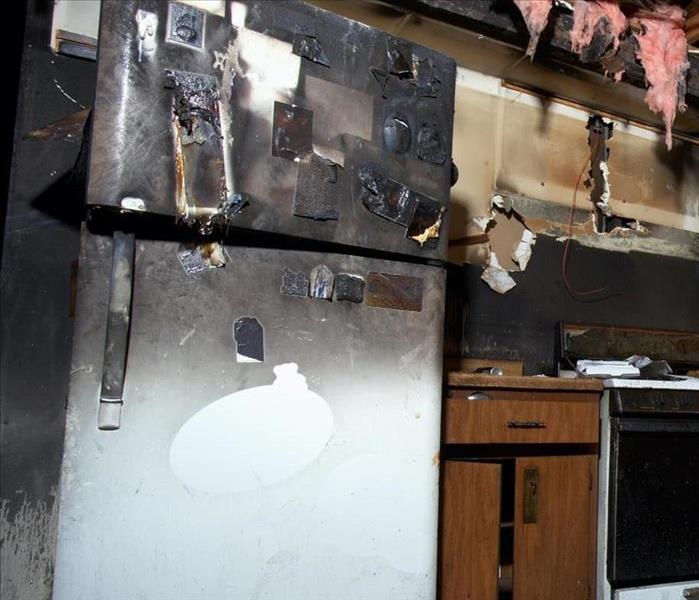After a Fire in a Home, Why are Smoke Residues So Hard to Remove?
10/15/2020 (Permalink)
SERVPRO techs bring the equipment and cleaners to handle any type of post-fire cleanup in Little Rock homes
When SERVPRO techs tackle the fire and smoke damage residues left behind in Little Rock homes, it takes both experience and knowledge to avoid doing more harm to surfaces instead of cleaning them. The reason that soot can be difficult to remove is because of the following factors:
- Different types of residues can exist in the same work-site
- Residues bond with the surfaces they contact, sometimes requiring stout methods to remove such as the use of solvents
- Testing the smoke type shows the dry or wet cleaning that will best suit the removal type needed
Do Homeowners Need Fire Restoration After a Kitchen Fire With No Visible Smoke Residues?
- When a kitchen needs cleanup and fire restoration services in a Little Rock home, SERVPRO techs test the residues, and they can get divided into three distinct categories:
- Dry smoke gets created by high heat fires, and while it is easier to remove, the heat levels needed to incur it tend to leave behind more significant damage to the structure
- Wet smoke gets created primarily when articles containing plastic or rubber burn, and it leaves a thick, greasy residue that is hard to remove without the use of solvents
- Protein residues occur when something containing protein such as a chicken, turkey, or pot roast, for example, catches aflame and burns to release the oils as airborne vapor droplets. These get deposited on nearby surfaces and, while nearly invisible, are highly pungent
Before any of the residues can get removed, whether dry, wet, or protein-based, SERVPRO technicians scope the area and make a note of the types of damage left in the room and then they:
- Test the residues to determine the type
- Note the building materials or surfaces affected to ensure the correct removal methods get chosen
- There are three main ways to get rid of residues through pick up using dry cleaning sponges, vacuuming, and use of solvents to dissolve the grip on the surface
After the initial cleanup, SERVPRO technicians must carefully dispose of dry cleaning solvents carefully and avoid sewers or septic systems per regulations. The techs follow the rules and regulations during the cleanup to the letter to ensure they always work within the law during the restoration service.
Some surfaces require disposal because they have too much charring or residues deeply embedded to remain on-site. The techs carefully remove these articles and dispose of them. Sheetrock generally has a poor outcome after exposure to high heat or the water used to extinguish a fire. The techs only remove the minimum amount necessary, so whenever possible, they can save homeowners the cost of replacing a whole wall.
One unusual type of residue that occasionally occurs and requires a light hand to clean up is smoke webs. They look exactly like black cobwebs and are lightweight, and do not stick to surfaces. The techs use dry cleaning sponges to lift them away from ceilings in corners where they typically gather. When homeowners attempt to clean up smoke residues on their own, this is one of the types that sometimes they get the technique wrong and wind up grinding the soot into the walls. Worse, if they use liquid cleaning agents, it can result in the complete ruination of the wall or ceiling.
Once the cleanup efforts complete, the technicians turn their attention to the air quality in the home. Air scrubbers run through the process to capture airborne particulates. If the restoration services got limited to a smaller area inside the house, the techs routinely use containment. This action gets accomplished by using heavy gauge plastic over doorways and vents or negative air chambers.
In particular, the techs want to avoid soot traveling into the ductwork of the home. Once the services complete, as a final step, the techs can inspect the ductwork and determine if it requires mitigation for cross-contamination. SERVPRO technicians have vacuums and other equipment for cleaning out the ducts and leaving it without a trace of fire odors.
Because soot has the potential to be both skin and breathing irritant and bring pungent odors, the techs perform any needed odor control treatments to ensure the home is ready for any repairs that need to occur.
Reach SERVPRO of Northwest Little Rock at (501) 803-9700 has the training and equipment to take on any size or type of fire restoration your property needs. The certified techs arrive quickly and work until the damage is, "Like it never even happened."






 24/7 Emergency Service
24/7 Emergency Service